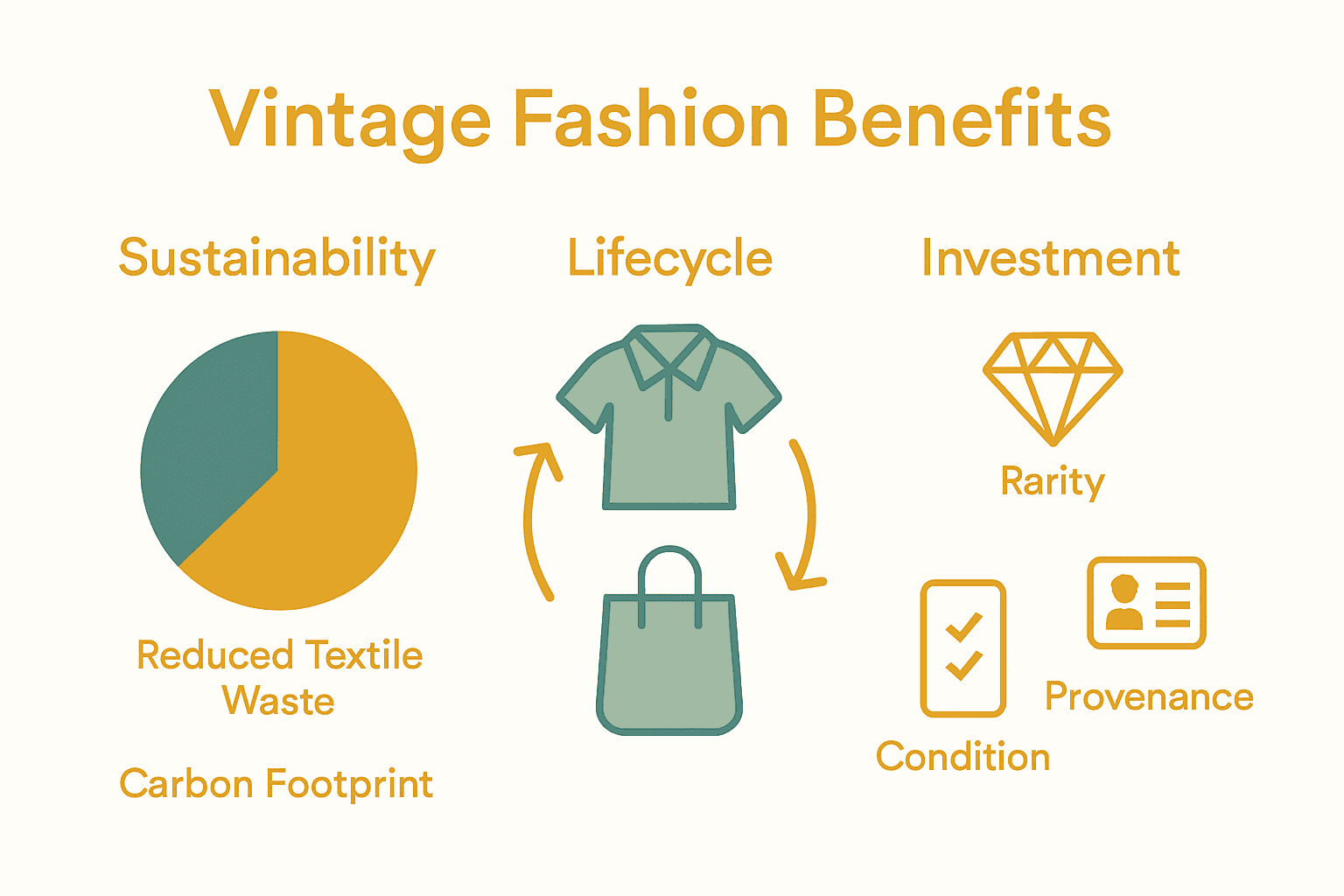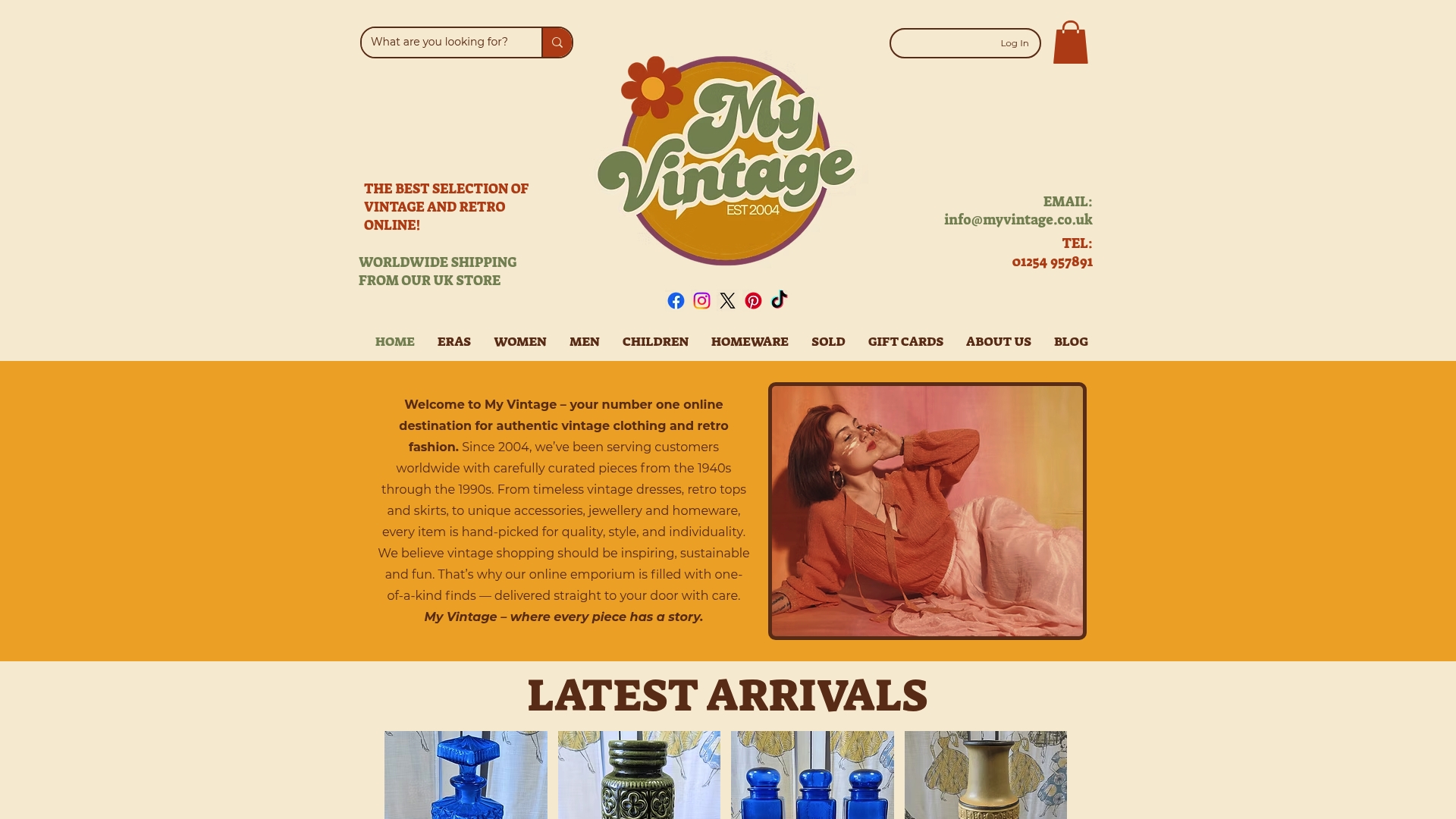Why Invest in Vintage Fashion? A Complete Guide
- Emma

- 1 day ago
- 7 min read

Did you know that the global market for vintage fashion is now valued at over $36 billion and continues to grow each year? Vintage clothing holds a special draw for people who crave quality, sustainability, and a touch of individuality in what they wear. Choosing true vintage means stepping into a world where every item carries its own story, distinct craftsmanship, and a link to fashion history that modern fast fashion cannot match.
Table of Contents
Key Takeaways
Defining Vintage Fashion and Its Appeal
Vintage fashion represents far more than simply wearing old clothing. According to irep.ntu.ac.uk, it’s a nuanced form of sartorial storytelling that celebrates historical authenticity and distinctive craftsmanship. These garments aren’t just fabric and thread - they’re living artifacts that capture the essence of past eras.
At its core, vintage fashion refers to genuine clothing pieces produced at least 20 years prior to the present moment. As researchportal.hw.ac.uk highlights, these pieces transcend cultural boundaries, offering wearers a unique opportunity to express individual style through meticulously crafted clothing that embodies specific historical aesthetics.
The appeal of vintage fashion extends far beyond mere nostalgia. It represents a profound connection to design history, sustainability, and personal expression. Key attractions include:
Unparalleled Quality: Vintage pieces often feature superior construction techniques compared to contemporary mass-produced clothing
Sustainability: Purchasing vintage reduces fashion waste and promotes circular economy principles
Uniqueness: Each vintage item tells a distinctive story, ensuring you won’t encounter identical pieces in every high street shop
Investment Potential: Well-preserved vintage clothing can appreciate in value over time
True vintage enthusiasts understand that these garments are more than clothing - they’re wearable art that connects us to previous generations’ creativity and craftsmanship. Whether you’re a serious collector or a casual admirer, understanding authentic vintage offers a fascinating journey into fashion’s rich, ever-evolving narrative.
Types and Eras of Vintage Clothing
Vintage clothing represents a vibrant tapestry of fashion history, spanning multiple distinct eras and styles. According to the Leeds Fashion Archive, this collection beautifully illustrates the rich diversity of 20th-century fashion, showcasing everything from haute couture to everyday wear that tells a compelling narrative of social and cultural evolution.
Vintage clothing eras can be broadly categorised into several distinctive periods, each with unique characteristics:
Victorian Era (1837-1901): As documented by The National Archives, this period featured dramatic silhouettes like crinolines and bustles, reflecting the era’s complex social norms and aesthetic sensibilities
1920s: The Jazz Age brought revolutionary flapper dresses with straight, loose cuts and dropped waistlines
1940s-1950s: Post-war fashion featuring structured silhouettes, nipped waists, and full skirts
1960s-1970s: Bold prints, psychedelic colours, and experimental designs characterized these transformative decades
Understanding vintage clothing types goes beyond mere chronological classification. Each piece represents a snapshot of cultural expression, technological capabilities, and societal values of its time. Stepping back in time to explore fashion eras reveals how clothing was not just about covering the body, but a profound form of personal and collective identity.
For collectors and fashion enthusiasts, recognising the nuanced differences between vintage clothing types becomes an art form. Whether you’re drawn to the structured elegance of mid-century designs or the rebellious spirit of 1960s fashion, each era offers a unique aesthetic waiting to be discovered and celebrated.

Here’s a comparison of key characteristics across major vintage fashion eras:
Investment Value and Market Trends
Vintage fashion has transformed from a niche interest to a significant market segment with compelling investment potential. According to research from pure.hud.ac.uk, the surge in vintage fashion popularity stems from multiple factors including changing consumer values, eco-sustainability concerns, and media influence.
Market dynamics in vintage fashion are complex and multifaceted. As documented by irep.ntu.ac.uk, retailers must carefully balance commercial strategies with maintaining the authentic appeal of vintage merchandise. This delicate equilibrium is crucial for attracting discerning consumers who value historical and material integrity.
Key investment considerations for vintage fashion include:
Rarity: Unique pieces from limited production runs appreciate faster
Condition: Immaculately preserved garments command significantly higher prices
Historical Significance: Items connected to specific cultural moments or designers carry premium value
Provenance: Documented history and original ownership can dramatically increase a piece’s worth
Understanding the types of vintage clothing becomes crucial for potential investors. Emerging collectors should focus on well-preserved pieces from iconic eras like mid-century haute couture or revolutionary design periods such as the 1920s and 1960s.
While vintage fashion represents an exciting investment landscape, success requires extensive research, keen market understanding, and a genuine passion for historical clothing. The most successful collectors view their acquisitions not merely as financial assets, but as wearable pieces of cultural heritage that tell compelling stories about human creativity and social evolution.
Sustainability and Environmental Benefits
Vintage fashion represents a powerful solution to the environmental challenges plaguing modern textile production. According to research from ualresearchonline.arts.ac.uk, vintage clothing embodies a profound narrative of sustainability, representing older values where garments were carefully maintained, repaired, and cherished rather than treated as disposable commodities.
Eco-fashion principles have emerged as a critical response to the fashion industry’s environmental footprint. As documented by pure.hud.ac.uk, sustainable fashion practices are gaining significant support from government bodies and environmental pressure groups, with vintage clothing playing a pivotal role in this transformative movement.
Key environmental benefits of choosing vintage fashion include:
Reduced Textile Waste: Extends the life cycle of existing garments
Lower Carbon Footprint: Eliminates the need for new manufacturing processes
Conservation of Resources: Prevents additional water, energy, and raw material consumption
Circular Fashion Economy: Promotes reuse and recycling of clothing
Understanding vintage clothing types becomes crucial for those committed to sustainable fashion choices. By selecting well-crafted, enduring pieces, consumers can make a meaningful environmental impact while expressing their unique personal style.
Ultimately, vintage fashion transcends mere clothing selection. It represents a conscious choice to challenge fast fashion’s throwaway culture, celebrating craftsmanship, individual expression, and environmental responsibility. Each vintage piece worn is a statement - a commitment to preserving our planet’s resources while honouring the rich heritage of textile design.

Financial Risks and Common Pitfalls
Investing in vintage fashion requires a nuanced understanding of market dynamics and potential risks. According to research from irep.ntu.ac.uk, the commercialisation of vintage fashion demands careful navigation between maintaining authenticity and attracting discerning consumers seeking distinctive styles.
The vintage fashion market is complex and influenced by multiple factors. As documented by pure.hud.ac.uk, consumer attitudes towards vintage clothing are shaped by changing values, media influence, and technological trends, which can significantly impact market volatility.
Common financial risks and pitfalls for vintage fashion investors include:
Authentication Challenges: High potential for counterfeit or misrepresented items
Condition Depreciation: Improper storage or handling can dramatically reduce value
Market Unpredictability: Trend-driven valuations that can fluctuate rapidly
Restoration Costs: Significant expenses for repairing or preserving delicate vintage pieces
Limited Liquidity: Specialised market with potentially slower resale opportunities
Understanding vintage clothing types becomes crucial for mitigating investment risks. Successful collectors develop expertise in historical fashion, learn meticulous assessment techniques, and cultivate a network of trusted experts and authenticators.
Ultimately, vintage fashion investment requires passion, patience, and profound market knowledge. While financial returns are possible, the most rewarding approach views these pieces as cultural artifacts rather than mere financial instruments. Approach vintage collecting as a journey of discovery, valuing historical significance over speculative potential.
Discover Authentic Vintage Fashion with Confidence
Navigating the intricate world of vintage fashion investment can feel overwhelming. You want to find pieces that offer authenticity, timeless style, and sustainability while avoiding pitfalls like poor condition or misrepresentation. At My Vintage, we understand these challenges and curate a diverse selection of carefully preserved vintage garments from the 1940s to the 1990s, ensuring every item carries genuine historical value and exceptional quality.

Explore our handpicked collection and embrace vintage fashion as a statement of individuality and conscious living. Whether you seek investment-worthy apparel or unique pieces to enrich your wardrobe, start your journey today by visiting My Vintage and learn more about understanding vintage clothing types. Don’t miss out on owning authentic vintage treasures that combine style, story, and sustainability right now.
Frequently Asked Questions
What is vintage fashion?
Vintage fashion refers to genuine clothing pieces produced at least 20 years prior. These garments are celebrated for their historical authenticity, distinctive craftsmanship, and unique ability to express individual style.
Why is vintage fashion considered sustainable?
Vintage fashion is sustainable because it reduces textile waste, lowers carbon footprints by eliminating the need for new manufacturing, conserves resources, and promotes a circular fashion economy through reuse and recycling of clothing.
What are the key investment factors in vintage fashion?
Key investment factors in vintage fashion include rarity, condition, historical significance, and provenance. Unique and well-preserved pieces from notable eras can appreciate in value over time.
What are the common risks when investing in vintage fashion?
Common risks include authentication challenges, condition depreciation, market unpredictability, restoration costs, and limited liquidity in the specialty market. Awareness and expertise are essential for successful investment.
Recommended






Comments